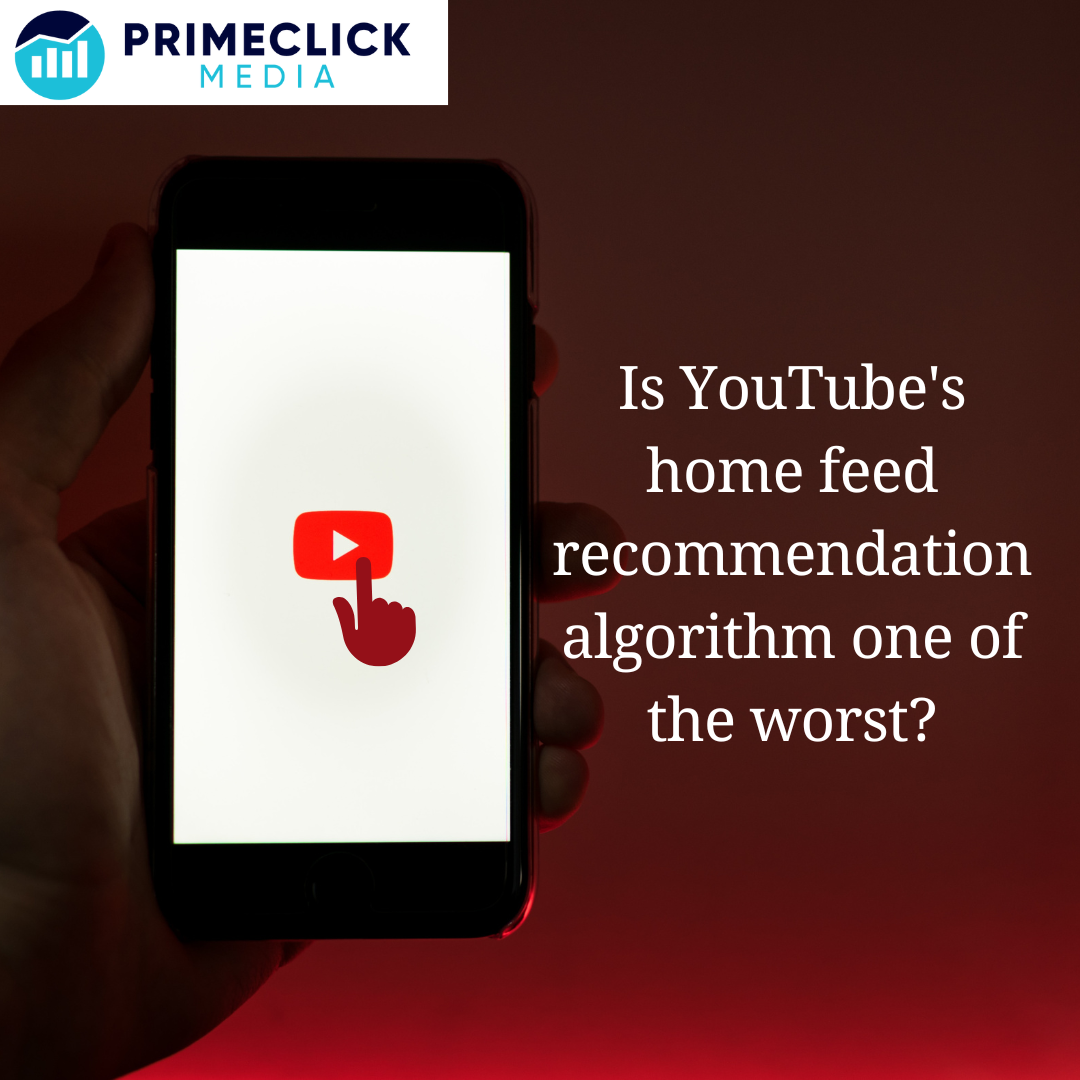We all love to spend time on YouTube, whether it’s catching up on the latest music videos, checking out DIY tutorials, or watching hilarious cat videos. But have you ever wondered why YouTube’s home feed sometimes feels like a rollercoaster ride, taking you on a wild journey from one unrelated video to another? It’s all thanks to YouTube’s recommendation algorithm, which some critics call “one of the worst.”
In this blog, we’ll explore the ups and downs of YouTube’s home feed and whether it truly lives up to its notorious reputation.
How Youtube’s Recommendation Algorithm Works?
YouTube’s recommendation algorithm is a complex system that uses machine learning and data analysis to suggest videos to users based on their viewing history, interactions, and preferences. While the specific details of the algorithm are proprietary and not publicly disclosed by YouTube, some general principles and factors are known to play a significant role in how it works.
Here’s an overview of how YouTube’s recommendation algorithm operates:
Viewing History and Interactions
The algorithm considers your past viewing history and interactions on YouTube. It takes into account the videos you have watched, liked, disliked, shared, and commented on. By analyzing this data, the algorithm tries to understand your interests and preferences to suggest relevant content.
Watch Time and Engagement
Watch time, or the amount of time you spend watching a video is a crucial metric for the recommendation algorithm. YouTube aims to keep users engaged on the platform for longer durations, so videos that have higher watch times are often prioritized in recommendations. Additionally, engagement metrics, such as likes, comments, and shares, also influence the algorithm’s suggestions.
Similar Content
YouTube’s recommendation algorithm looks for videos that are similar to the ones you’ve watched and enjoyed in the past. It takes into account the content of the videos, the topics covered, and the language used to identify patterns and similarities.
Related Videos
When you watch a video, YouTube suggests a list of related videos based on the content and subject matter. These related videos are often chosen using the recommendation algorithm to offer you more options aligned with your interests.
Personalization
YouTube’s algorithm aims to create a personalized experience for each user. It adapts its suggestions over time, constantly learning from your behavior and interactions to improve the accuracy of its recommendations.
Diverse Content
While YouTube aims to personalize recommendations, it also strives to offer a diverse range of content to users. This means that even if you have a specific interest, the algorithm may occasionally introduce new topics or perspectives to broaden your experience.
Trending and Fresh Content
The algorithm also takes into account the popularity of videos, with a focus on trending and fresh content. New videos that are gaining traction and receiving high engagement are likely to appear in recommendations.
User Feedback
YouTube encourages user feedback on the videos they watch. Utilizing features like the “Not Interested” button, “Don’t Recommend Channel,” and feedback on content quality helps the algorithm understand user preferences better.
Ups and Downs of YouTube’s Recommendation Algorithm
The Upsides of YouTube’s Algorithm
Let’s start with the bright side. YouTube’s recommendation algorithm is a marvel of artificial intelligence. It uses machine learning to analyze your viewing history, likes, and dislikes to suggest content that you might find interesting. This means you’re more likely to discover new and exciting videos that align with your preferences. It’s like having a personal video curator, handpicking content just for you!
Riding the Wild Rollercoaster
But here’s where the rollercoaster takes a twist. As smart as YouTube’s algorithm is, it’s not without its flaws. Many users have complained that the algorithm can be too aggressive in pushing certain content, leading to a repetitive and sometimes irrelevant home feed. Ever watched a single cooking video, only to be bombarded with hundreds of recipe suggestions for weeks? We’ve all been there!
Echo Chambers and Extremes
Another concern with YouTube’s algorithm is the potential for creating echo chambers. If you watch a lot of videos from a particular viewpoint or ideology, the algorithm may keep feeding you similar content, reinforcing your existing beliefs and limiting exposure to diverse perspectives. This can lead to an unhealthy echo chamber, where you only see one side of the story.
Moreover, the algorithm’s focus on engagement metrics (likes, views, watch time) can push controversial or extreme content to the forefront. While this might boost interaction, it can also contribute to the spread of misinformation and polarizing content.
Striking the Right Balance
So, is YouTube’s home feed recommendation algorithm the worst? It’s a tough call. While it has its flaws, YouTube is aware of the challenges and is constantly fine-tuning the algorithm to strike a better balance. In recent years, they have made efforts to reduce the spread of harmful content and provide users with more control over their recommendations.
Take Control of Your YouTube Experience
Ultimately, the power lies in your hands. You can take control of your YouTube experience by using features like the “Not Interested” button or clearing your watch history. Additionally, subscribing to channels you genuinely enjoy can influence the algorithm to suggest content that aligns with your true interests.
How to Reset YouTube Recommendations
If you want to reset your YouTube recommendations and start receiving fresh suggestions, you can do so by clearing your watch history and pausing your watch and search history. Here’s how you can do it:
Clear Watch History
- Open the YouTube app or go to the YouTube website on your computer.
- Make sure you are signed in to your YouTube account.
- Tap on your profile picture or avatar in the top-right corner to access your account menu.
- From the menu, select “History.” On the YouTube website, you can find “History” in the left sidebar.
- Click on “Clear all watch history” or “Clear all watch history” on the YouTube app.
- Confirm the action when prompted.
Pause Watch and Search History
- While still in the “History” section, click on “Pause watch history” or “Pause watch history” on the YouTube app.
- Confirm the action when prompted.
Clear Search History (Optional)
If you want to ensure that your search history doesn’t influence future recommendations, you can clear it as well:
- From the “History” section, click on “Clear all search history” or “Clear all search history” on the YouTube app.
- Confirm the action when prompted.
Keep in mind that clearing your watch and search history will reset your YouTube recommendations and may lead to a temporary period where you receive more generic suggestions. As you watch new videos and engage with content, the recommendation algorithm will start learning your preferences again and offer personalized suggestions based on your updated viewing habits.
Please note that resetting your recommendations will not affect your subscriptions or the videos you have liked or disliked; it only clears your watch and searches history data. If you wish to return to your previous recommendations at any time, you can enable your watch and search history again, and YouTube will resume offering personalized suggestions based on your past activity.
How to Get Better YouTube Recommendations?
To improve the quality of your YouTube recommendations and receive more relevant and enjoyable content, you can take the following steps:
Watch and Engage with Preferred Content
Spend time watching videos that genuinely interest you. When you come across a video you enjoy, click the thumbs-up (like) button, leave a positive comment, or share it. Engaging with content you like helps YouTube understand your preferences better.
Subscribe to Channels
Subscribe to channels that consistently produce content you enjoy. Subscribing to channels tells YouTube that you are interested in their videos, and the algorithm will prioritize showing you content from these channels.
Use the “Not Interested” Button
If you encounter videos that don’t interest you or are not relevant, use the “Not Interested” button to let YouTube know. Clicking this option on a video’s menu will prevent similar content from appearing in your recommendations.
Explore Different Topics
Don’t limit yourself to one type of content. Explore a variety of topics that genuinely intrigue you. This can help broaden your recommendations and introduce you to new and exciting content.
Give Feedback on Recommendations
YouTube provides feedback options for recommendations. If a video doesn’t match your interests, you can click on the three dots next to the recommendation and select “Not interested in this recommendation” to provide feedback.
Clear Your Watch History and Pause It
As mentioned earlier, clearing your watch history and pausing it for a while can give you a fresh start and help the algorithm adjust to your updated interests.
Use Playlists and Watch Later
Utilize playlists to organize videos you want to watch based on different themes or interests. Also, add videos you want to watch later to your “Watch Later” list. This can help YouTube understand your preferences better.
Interact with the Homepage
Engage with the videos on your homepage. Watch videos, like, or dislike them based on your preferences. This active participation helps the algorithm fine-tune your recommendations.
Avoid Clickbait and Low-Quality Content
Clickbait and low-quality videos may temporarily attract your attention, but engaging with them can skew your recommendations. Try to focus on reputable and informative content.
Be Patient
The YouTube recommendation algorithm constantly evolves based on your viewing behavior. It may take some time for it to accurately understand your preferences and provide better recommendations.
Conclusion
YouTube’s home feed recommendation algorithm is a double-edged sword. On one hand, it helps us discover exciting new videos tailored to our tastes. On the other, it can feel like a relentless rollercoaster ride, bombarding us with repetitive or extreme content. However, with YouTube’s ongoing efforts to improve the algorithm and users taking control of their viewing experience, there’s hope for a smoother and more enjoyable ride ahead.
So, buckle up and enjoy the YouTube journey while keeping a discerning eye on your home feed!





